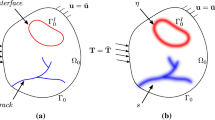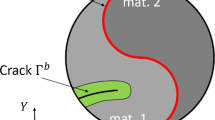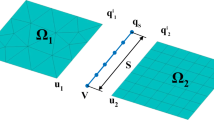Abstract
Interfacial cracking occurs in many engineering problems such as delamination in composite laminates, matrix/interface debonding in fibre reinforced composites etc. Computational modelling of these interfacial cracks usually employs compatible or matching cohesive interface elements. In this paper, incompatible or non-matching cohesive interface elements are proposed for interfacial fracture mechanics problems. They allow non-matching finite element discretisations of the opposite crack faces thus lifting the constraint on the compatible discretisation of the domains sharing the interface. The formulation is based on a discontinuous Galerkin method and works with both initially elastic and rigid cohesive laws. The proposed formulation has the following advantages compared to classical interface elements: (i) non-matching discretisations of the domains and (ii) no high dummy stiffness. Two and three dimensional quasi-static fracture simulations are conducted to demonstrate the method. Our method not only simplifies the meshing process but also it requires less computational demands, compared with standard interface elements, for problems that involve materials/solids having a large mismatch in stiffnesses.

























Similar content being viewed by others
Notes
The force terms are standard and thus omitted for sake of presentation.
Searching for neighbouring elements is efficiently done using the technique of bounding boxes.
Herein we made an assumption that the geometry of the interface \(\varGamma ^*\) has been well represented by the geometrically approximate FE domain meshes. This is to ensure that Eq. (34) has solutions. In case that this assumption cannot be guaranteed one needs to find the closest point projection of \(\mathbf {x}_k\) on \(\varOmega ^2\), commonly used in contact mechanics, readers are referred to the pre-processing algorithm in [48] for details.
Jem-Jive has become open sourced since February 2016 at http://jive.dynaflow.com.
The two domains separated by the interfacial crack are meshed independently using a Matlab script and the input required by the procedure described in Sect. 5 is also generated by this script.
References
Agwai A, Guven I, Madenci E (2011) Crack propagation in multilayer thin-film structures of electronic packages using the peridynamic theory. Microelectron Reliab 51(12):2298–2305
Alfano G, Crisfield MA (2001) Finite element interface models for the delamination analysis of laminated composites: mechanical and computational issues. Int J Numer Meth Eng 50(7):1701–1736
Allix O, Ladevèze P, Corigliano A (1995) Damage analysis of interlaminar fracture specimens. Compos Struct 31(1):61–74
Álvarez D, Blackman B, Guild F, Kinloch A (2014) Mode I fracture in adhesively-bonded joints: a mesh-size independent modelling approach using cohesive elements. Eng Fract Mech 115:73–95
Armero F, Linder C (2009) Numerical simulation of dynamic fracture using finite elements with embedded discontinuities. Int J Fract 160(2):119–141
Barenblatt G (1962) The mathematical theory of equilibrium cracks in brittle fracture. Adv Appl Mech 7:55–129
Becker G, Noels L (2013) A full-discontinuous Galerkin formulation of nonlinear Kirchhoff-Love shells: elasto-plastic finite deformations, parallel computation, and fracture applications. Int J Numer Meth Eng 93(1):80–117
Benzeggagh M, Kenane M (1996) Measurement of mixed-mode delamination fracture toughness of unidirectional glass/epoxy composites with mixed-mode bending apparatus. Compos Sci Technol 56(4):439–449
Bishop J (2009) Simulating the pervasive fracture of materials and structures using randomly close packed Voronoi tessellations. Comput Mech 44(4):455–471
Bordas S, Nguyen PV, Dunant C, Guidoum A, Nguyen-Dang H (2007) An extended finite element library. Int J Numer Meth Eng 71(6):703–732
Bordas S, Rabczuk T, Zi G (2008) Three-dimensional crack initiation, propagation, branching and junction in non-linear materials by an extended meshfree method without asymptotic enrichment. Eng Fract Mech 75(5):943–960
Camacho G, Ortiz M (1996) Computational modelling of impact damage in brittle materials. Int J Solids Struct 33(2022):2899–2938
Carol I, López CM, Roa O (2001) Micromechanical analysis of quasi-brittle materials using fracture-based interface elements. Int J Numer Meth Eng 52(1–2):193–215
da Costa DD, Alfaiate J, Sluys L, Júlio E (2009) A discrete strong discontinuity approach. Eng Fract Mech 76(9):1176–1201
Dimitri R, De Lorenzis L, Wriggers P, Zavarise G (2014) NURBS-and T-spline-based isogeometric cohesive zone modeling of interface debonding. Comput Mech 54(2):369–388
Do B, Liu W, Yang Q, Su X (2013) Improved cohesive stress integration schemes for cohesive zone elements. Eng Fract Mech 107:14–28
Dugdale D (1960) Yielding of steel sheets containing slits. J Mech Phys Solids 8(2):100–104
Embar A, Dolbow J, Harari I (2010) Imposing Dirichlet boundary conditions with Nitsche’s method and spline-based finite elements. Int J Numer Meth Eng 83(7):877–898
Espinosa HD, Zavattieri PD, Dwivedi SK (1998) A finite deformation continuum-discrete model for the description of fragmentation and damage in brittle materials. J Mech Phys Solids 46(10):1909–1942
Fritz A, Hüeber S, Wohlmuth B (2004) A comparison of mortar and Nitsche techniques for linear elasticity. CALCOLO 41(3):115–137
Gens A, Carol I, Alonso E (1989) An interface element formulation for the analysis of soil-reinforcement interaction. Comput Geotech 7(12):133–151
Geuzaine C, Remacle JF (2009) Gmsh: a three-dimensional finite element mesh generator with built-in pre- and post-processing facilities. Int J Numer Meth Eng 79(11):1309–1331
Griebel M, Schweitzer MA (2002) A particle-partition of unity method. Part V: Boundary Conditions. In: Hildebrandt S, Karcher H (eds) Geometric analysis and nonlinear partial differential equations. Springer, Berlin, pp 519–542
Ha YD, Bobaru F (2011) Characteristics of dynamic brittle fracture captured with peridynamics. Eng Fract Mech 78(6):1156–1168
Hallett S, Green B, Jiang WG, Cheung K, Wisnom M (2009) The open hole tensile test: a challenge for virtual testing of composites. Int J Fract 158(2):169–181
Henderson A (2007) ParaView guide. A parallel visualization application. Kitware Inc, Clifton Park
Hille T, Suiker A, Turteltaub S (2009) Microcrack nucleation in thermal barrier coating systems. Eng Fract Mech 76(6):813–825
Hillerborg A, Moder M, Petersson P (1976) Analysis of crack formation and crack growth in concrete by means of fracture mechanics and finite elements. Cem Concr Res 6(6):773–781
Hughes T, Cottrell J, Bazilevs Y (2005) Isogeometric analysis: CAD, finite elements, NURBS, exact geometry and mesh refinement. Comput Methods Appl Mech Eng 194(39–41):4135–4195
Kaczmarczyk L, Pearce CJ, Bićanić N, de Souza Neto E (2010) Numerical multiscale solution strategy for fracturing heterogeneous materials. Comput Methods Appl Mech Eng 199(1720):1100–1113
Kerfriden P, Allix O, Gosselet P (2009) A three-scale domain decomposition method for the 3D analysis of debonding in laminates. Comput Mech 44(3):343–362
Klein P, Foulk J, Chen E, Wimmer S, Gao H (2001) Physics-based modeling of brittle fracture: cohesive formulations and the application of meshfree methods. Theor Appl Fract Mech 37(13):99–166
Lingen EJ, Stroeven M (2002) Jem/Jive-a C++ numerical toolkit for solving partial differential equations. http://www.habanera.nl/
Liu R, Wheeler M, Dawson C (2009) A three-dimensional nodal-based implementation of a family of discontinuous Galerkin methods for elasticity problems. Comput Struct 87(34):141–150
Marder M, Liu X (1993) Instability in lattice fracture. Phys Rev Lett 71:2417–2420
van der Meer F, Sluys L (2010) Mesh-independent modeling of both distributed and discrete matrix cracking in interaction with delamination in composites. Eng Fract Mech 77(4):719–735
van der Meer FP, Sluys LJ, Hallett SR, Wisnom MR (2012) Computational modeling of complex failure mechanisms in laminates. J Compos Mater 46(5):603–623
Mergheim J, Kuhl E, Steinmann P (2004) A hybrid discontinuous Galerkin/interface method for the computational modelling of failure. Commun Numer Methods Eng 20(7):511–519
Miehe C, Hofacker M, Welschinger F (2010) A phase field model for rate-independent crack propagation: robust algorithmic implementation based on operator splits. Comput Methods Appl Mech Eng 199(4548):2765–2778
Moës N, Dolbow J, Belytschko T (1999) A finite element method for crack growth without remeshing. Int J Numer Meth Eng 46(1):131–150
Nguyen VP (2014a) Discontinuous Galerkin/Extrinsic cohesive zone modeling: implementation caveats and applications in computational fracture mechanics. Eng Fract Mech 128:37–68
Nguyen VP (2014b) An open source program to generate zero-thickness cohesive interface elements. Adv Eng Softw 74:27–39
Nguyen VP, Nguyen-Xuan H (2013) High-order B-splines based finite elements for delamination analysis of laminated composites. Compos Struct 102:261–275
Nguyen VP, Kerfriden P, Bordas S (2014a) Two- and three-dimensional isogeometric cohesive elements for composite delamination analysis. Compos B 60:193–212
Nguyen VP, Kerfriden P, Bordas S, Rabczuk T (2014b) An integrated design-analysis framework for three dimensional composite panels. Comput Aid Des 55:49–63
Nguyen VP, Kerfriden P, Brino M, Bordas S, Bonisoli E (2014c) Nitsche’s method for two and three dimensional NURBS patch coupling. Comput Mech 53(6):1163–1182
Noels L, Radovitzky R (2006) A general discontinuous Galerkin method for finite hyperelasticity. Formulation and numerical applications. Int J Numer Meth Eng 68(1):64–97
Paggi M, Wriggers P (2016) Node-to-segment and node-to-surface interface finite elements for fracture mechanics. Comput Methods Appl Mech Eng 300:540–560
Pandolfi A, Ortiz M (2002) An efficient adaptive procedure for three-dimensional fragmentation simulations. Eng Comput 18(2):148–159
Prechtel M, Ronda P, Janisch R, Hartmaier A, Leugering G, Steinmann P, Stingl M (2011) Simulation of fracture in heterogeneous elastic materials with cohesive zone models. Int J Fract 168(1):15–29
Rabczuk T, Belytschko T (2007) A three-dimensional large deformation meshfree method for arbitrary evolving cracks. Comput Methods Appl Mech Eng 196(2930):2777–2799
Radovitzky R, Seagraves A, Tupek M, Noels L (2011) A scalable 3D fracture and fragmentation algorithm based on a hybrid, discontinuous Galerkin, cohesive element method. Comput Methods Appl Mech Eng 200(14):326–344
Remmers J, de Borst R (2001) Delamination buckling of fibre-metal laminates. Compos Sci Technol 61(15):2207–2213
Sanders JD, Laursen T, Puso M (2011) A Nitsche embedded mesh method. Comput Mech 49(2):243–257
Schellekens J, Borst RD (1993) A non-linear finite element approach for the analysis of mode-I free edge delamination in composites. Int J Solids Struct 30(9):1239–1253
Schellekens JCJ, De Borst R (1993) On the numerical integration of interface elements. Int J Numer Meth Eng 36(1):43–66
Simo JC, Oliver J, Armero F (1993) An analysis of strong discontinuities induced by strain-softening in rate-independent inelastic solids. Comput Mech 12(5):277–296
Strouboulis T, Copps K, Babuka I (2001) The generalized finite element method. Comput Methods Appl Mech Eng 190(3233):4081–4193
Tijssens MGA, Sluys LJ, van der Giessen E (2001) Simulation of fracture of cementitious composites with explicit modeling of microstructural features. Eng Fract Mech 68(11):1245–1263
Turon A, Camanho P, Costa J, Dávila C (2006) A damage model for the simulation of delamination in advanced composites under variable-mode loading. Mech Mater 38(11):1072–1089
Vajari DA, Legarth BN, Niordson CF (2013) Micromechanical modeling of unidirectional composites with uneven interfacial strengths. Eur J Mech A Solids 42:241–250
Verhoosel C, Gutiérrez M (2009) Modelling inter- and transgranular fracture in piezoelectric polycrystals. Eng Fract Mech 76(6):742–760
Wagner W, Gruttmann F, Sprenger W (2001) A finite element formulation for the simulation of propagating delaminations in layered composite structures. Int J Numer Meth Eng 51(11):1337–1359
Wu L, Tjahjanto D, Becker G, Makradi A, Jérusalem A, Noels L (2013) A micromeso-model of intra-laminar fracture in fiber-reinforced composites based on a discontinuous Galerkin/cohesive zone method. Eng Fract Mech 104:162–183
Xu X, Needleman A (1993) Void nucleation by inclusion debonding in a crystal matrix. Model Simul Mater Sci Eng 1(2):111
Xu X, Needleman A (1994) Numerical simulations of fast crack growth in brittle solids. J Mech Phys Solids 42(9):1397–1434
Acknowledgments
Funding support from the Australian Research Council via project DE160100577 (Vinh Phu Nguyen) is gratefully acknowledged. Stephane Bordas is sincerely grateful for the financial support of the European Research Council Starting Independent Research Grant (ERC grant agreement no. 279578): Towards real time multiscale simulation of cutting in non-linear materials with applications to surgical simulation and computer guided surgery. The authors would like to express the gratitude towards Drs. Erik Jan Lingen and Martijn Stroeven at the Dynaflow Research Group, Houtsingel 95, 2719 EB Zoetermeer, The Netherlands for providing us the numerical toolkit jem/jive.
Author information
Authors and Affiliations
Corresponding author
Rights and permissions
About this article
Cite this article
Nguyen, V.P., Nguyen, C.T., Bordas, S. et al. Modelling interfacial cracking with non-matching cohesive interface elements. Comput Mech 58, 731–746 (2016). https://doi.org/10.1007/s00466-016-1314-y
Received:
Accepted:
Published:
Issue Date:
DOI: https://doi.org/10.1007/s00466-016-1314-y




